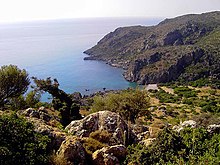Lissus (Crete)

Lissus or Lissos (
This Cretan city was an episcopal see in the time of Hierocles.[3] The order in which Flaminius Cornelius mentions it with the other bishoprics in the west part of the island agrees very well with its actual location in Agios Kirikos area, near the small village of Sougia, 70 km south of Chania.[4][5]
Of all the towns which existed on this part of the coast, Lissus alone seems to have struck coins, a fact which agrees very well with the evidence supplied by its situation, of its having been a place of some trading importance. The harbour is mentioned in the
Situation and archaeology

This place occupies a small hollow of the hills facing the sea, like a theatre. Near the church of the Panaghia are what appear to be vestiges of an ancient temple, consisting of granite columns, and white marble fragments, architraves, and pediments. Further on, appears to have been another temple, and a theatre. The tombs with arched rooves, are on the southwest side of the plain on the cliffside overlooking the site. There are perhaps fifty of them.[7]
In 1957–58 the city was excavated by N. Platon and archaeologists. They discovered ruins of a theatre, aqueduct, a cemetery, ancient baths, and Palaeo-Christian basilicas. In the area, they also found many statues and votive objects, which are now exhibited at the new Archaeological Museum of Chania (reopened in 2022). An ancient theatre, or Odeon, was uncovered at the site of Lissos in 2023, one of the great archaeological discoveries of that year.
In no other city of Crete, apart from
The small beach is a coarse pebble beach. Nobody lives in Lissos nowadays. It is reachable from Sougia by boat or by foot (90 minute walk through the Lissos Gorge).
See also
References
- ^ Ptolemy. The Geography. Vol. 3.17.3.
- ^ Stadiasmus Maris Magni
- ^ Comp. Cornel. Creta Sacra, vol. i. p. 235.
- ISBN 978-0-691-03169-9.
- ^ Lund University. Digital Atlas of the Roman Empire.
- ^ Comp. Joseph Hilarius Eckhel, Doctrina numorum veterum, vol. ii. p. 315.
- ^ Robert Pashley, Trav. vol. ii. p. 88; Mus. Class. Ant. vol. ii. p. 298.
![]() This article incorporates text from a publication now in the public domain: Smith, William, ed. (1854–1857). "Lissus". Dictionary of Greek and Roman Geography. London: John Murray.
This article incorporates text from a publication now in the public domain: Smith, William, ed. (1854–1857). "Lissus". Dictionary of Greek and Roman Geography. London: John Murray.
